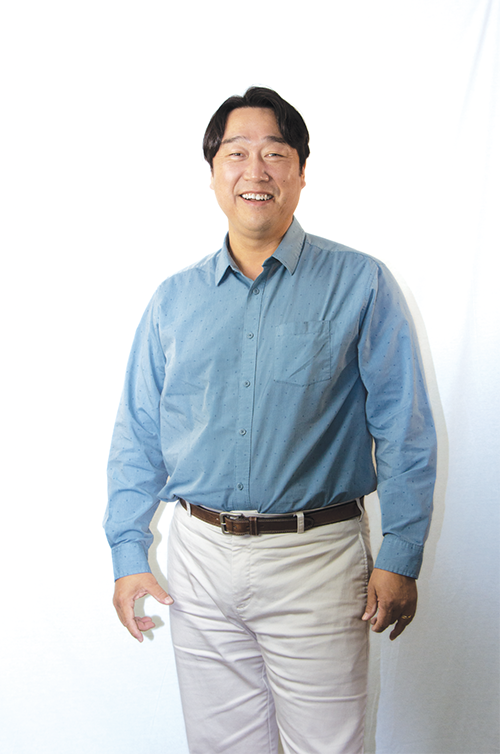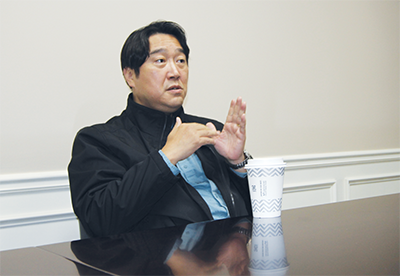“Find New Opportunities outside the Ethnic Hair Market!”
Interview with Director Brian Lee of A Plus
“While barriers to entry for White and Hispanic hair market are relatively high, it has the unlimited potential for growth and sustainable profit once you get in.”
Beauty supply industry fell in the swamp of negative growth. As the number of competitors grew, the competition to win an already crowded market is getting fiercer. Meanwhile, the profitability plummeted. Now, the belief that beauty supply industry should expand into non-ethnic beauty market is prevailing among many insiders. However, it is easier said than done. Not many can answer the basic questions like “How?” and “What?”. The non-ethnic beauty market is still an uncharted territory for many of us.
Director Brian Lee of A Plus, a hair company focused on White hair products, told us “while the barrier to entry for the White hair market is relatively high, it promises sustainable profit once you get in. The market truly has an unlimited potential for growth.” We invited him to BNB and talked over several topics such as “the current status of ethnic hair market and its limits” and “the potential of White hair market and how to enter.”
“Helped more than 300 beauty supplies’ build-up for White hair business providing consultation”
He is one of handful experts for White hair products. He came to the U.S. in his early 30s and worked as a hair sales representative for almost twenty years. He worked in the Black hair industry for 10 years, and he started working at A Plus, a hair company specialized in White hair products, for 7 years since 2014. Therefore, he has a good overall understanding of both White and Black hair market. Director Lee reportedly helped more than 300 beauty supplies over the past seven years by providing consultation as to White hair products and assisting business build-up.

How do you evaluate the current beauty supply market?
Through this pandemic, the beauty supply businesses proved that how strong and resilient they are. While many other businesses had a big dent in their book, beauty supplies stood firm. On the other hand, we also realized that the Black beauty market has reached its maximum level of growth. Competition is getting fierce, and profitability is plummeting. Now is the time to look into Hispanic and White market.
What is the current status of White/Hispanic market?
Currently, Sally and e-Commerce companies dominate Hispanic and White hair market. A tiny hair section within a Sally Beauty store surpasses the gross revenue of a typical beauty supply store. If you look at those products sold at Sally, you would realize they are much more expensive than products sold at beauty supplies. Their quality, on the other hand, is poorer than products’ sold at beauty supplies.
As you all know, the Hispanic population has exceeded the Black population in the U.S. Despite knowing all, we are exclusively focusing on Black hair market. The desire to be beautiful is equal to every ethnicity. It is the status quo of the beauty supply industry that you are not making a move to win a market with great potential.
How many beauty supply retail stores have entered the White/Hispanic market?
Approximately, about 5% of all beauty supply retail stores are carrying White beauty products. Those are stores sat on the borderline between Black and White/Hispanic communities. As they are vastly scattered, I have my own difficulty traveling between them (laughter). The future holds beyond the borderline, and you should enter the mainstream market consisting of 80%–90% White population.
What’s the consumer demand for White/Hispanic hair products?
The demand for White or Hispanic female hair products is not at all insignificant. They have genetically weak hair, so it is hard to grow hair beyond 12 inches. It is thin and brittle. That is why they are a big consumer for hair extension products.
Hispanic women tend to keep their hair short and use wigs and other hair products to wear long hair as desired.
What is the first base to carry White beauty products?
First, you should find a good sales representative from a good company, who can really help out.
In contract to Black hair consumers, White beauty consumers tend to extend their natural hair with compatible products, so they are comparatively pickier. There is a reason that you have more than 50 colors per item. If you have enough size to purchase all the colors in your inventory, that would be nice. But realistically, you ought to confine yourself with carrying 10–20 colors. Hence, you should receive help from sales associates of hair companies in order to choose appropriate items and color selections based on the market characteristics of your locale. Even more expertise is required in the White hair market that the Black counterpart.
Why are bigger hair companies not entering the White hair market?
As I said earlier, White hair market requires even more sophistication and expertise of sales representatives than Black hair market does. Nevertheless, this is a comparatively smaller market as of today, so big companies probably do not have resources to train their employees or do not have a good reason to do so.
How do you research the market before consultation?
We gather various data about the ethnic composition of the population and income levels. And we go out to the field and observe the consumers in busy commercial areas such as a shopping mall with fast food chain stores. We try to find out if they have many Hispanic, Jewish, or White consumers. We also figure out the age composition of the consumers. Based on the consumer analysis of the locale, we recommend preferred items and colors.

————————————————————————————-
Know-how to Succeed in White Hair Business by Director Lee
Realize the needs of your customers.
Typical Black consumers settle with products with alternative colors, but White consumers are different. All colored human hair extensions come with slightly different hue and tone even if the color label says the same. This is especially true for blonde hairs. They are out in the store to check if the extension’s color matches their own hair accurately. You ought to have the color your customers want.
Have a dedicated section.
If you commingle White and Black products, it will be hard to find products for both customer groups. White consumers tend to go straight to the section with products they look for instead of browsing through all sections. If it is hard to find the right section in the store, that can be a problem.
Have patience and perseverance.
It takes a longer time to take a hold of the White market compared to the Black market. Fortunately, White products are less vulnerable to trend as you can still sell virtually the same products that came out ten years ago. That gives you a leverage for enduring the early days of business build-up.
Target the suburban areas of big cities.
To enter the White majority areas, you need to have substantial investment and patience for the time to endure high rents and wait for business build-up. If you start with a smaller capital, you can realistically start in a suburban area that has both White and Black population. Also, you can target areas with a high Hispanic population. Especially, if you have Sally Beauty stores around, you can safely assume that there is demand for White hair products.
————————————————————————————-

Black products
When compared to White products, they sell relatively easily without much thought given. However, the trend is dynamic. They say 3-month is the duration of a trend nowadays. You have so-called “slow moving Items” that result in significant loss. The revenue fluctuates seasonally.
Although Black products are overall selling really well, fast moving merchandise suffers shortage of
supplies. As the low-end products sell well, profitability decreases. Bulky braids became the main sellers, and now you lift a lot of weights while stocking. As the sophistication level is low, the barrier to entry is low. That fuels the competition. As customers have less sensitivity toward color differentials, they can easily make online purchases. The growth of e-Commerce increases the risks and variability.
White products
It takes longer to secure a customer base. However, once you reach the level, you can maintain it. You can expect stable revenue and fixed income.
Products are less trendy. Our company has an item that has lasted 17 years.
While they have high sensitivity to color, they have low sensitivity to price. While it requires expertise, the average price is higher. In short, you have a high barrier to entry and a stable business in a long run.
Nowadays, they say small beauty supply retail stores are in trouble, what about small businesses carrying White hair products?
Many smaller beauty supply retail stores are closing their doors because the owners cannot find a buyer for the business. This is not typical of small businesses that have a White customer base.
Please introduce A Plus.
It was started about twenty years ago in Dallas by President Hongguen Yoo and Vice President Jinsoo Lee. In the beginning, it targeted both Black and White consumers, but to have a competitive edge against big companies, it transitioned into a company specialized in White-focused products. In hindsight, it was a right decision. I also think I was fortunate that I could develop expertise in this field. Our main products are clip or tape extension products made of 100% top-notch human hair to eliminate tangle and made to last. We do have synthetic products as well. Our products are available in more than 50 colors, so you can easily cover Black and Latino consumers.
Do you have anything you want to add?
Currently, most business owners in the White hair market are doing pretty well. Although the beginning is tough, if you endure it, you will pick a sweet fruit. You should broaden your scope of beauty business. Thank you.